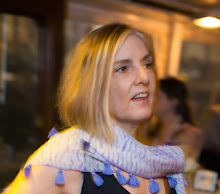
 When we moved into our house four years ago there was already an established bed of fountain grass (Pennisetum, also known as Feathertop) growing close to the front porch. I planted another clump of it closer to the sidewalk because I love it so much. In late summer and into the fall it blooms, carrying spikes of fuzzy and feathery flowers that can double the size of the plant. I suppose it's called "fountain grass" because its structure is that of a fountain; the clump grows from a central area and the grass falls in a lovely curve outside of the center.
When we moved into our house four years ago there was already an established bed of fountain grass (Pennisetum, also known as Feathertop) growing close to the front porch. I planted another clump of it closer to the sidewalk because I love it so much. In late summer and into the fall it blooms, carrying spikes of fuzzy and feathery flowers that can double the size of the plant. I suppose it's called "fountain grass" because its structure is that of a fountain; the clump grows from a central area and the grass falls in a lovely curve outside of the center. Fountain grasses are interesting for lots of reasons--they offer striking contrast to flowers and other shrubbery, they have these provocative and irresistible spikey fronds that come out in late summer/fall, and they turn a gorgeous orange/beige color in the fall. I appreciate all these qualities of fountain grass, and I especially appreciate that once they are established they need almost no care at all. Both of mine are thriving though I do nothing for them.
Mostly I like fountain grass, though, because it is a hardy grass. When I lived in the midwest, Iowa and Illinois, I fell in love with the hardy prairie grasses that dominate what is left of the prairies there, and in general I have come to appreciate hardiness in a plant over traditional beauty (more about this when I talk about the swamp rose in my front yard). There's also something almost subversive in planting a grass in your yard that you never intend to cut. OK, well, I do cut it back in Spring to give the new growth room, but there's none of this constant trimming that most people do with grass: I am in charge you will never seed or flower, not on my watch.
I live in an urban neighborhood so my lawn is very small. When we do cut the grass it's with a rusty push mower. Everywhere there is fountain grass, I don't need the mower, which pleases me. I admire how strong it is--deep rooted, almost impossible to pull up, resistant to disease, at home almost anywhere, and yet it has a graceful, arching shape that feels like a kind of sacred perfection. They are the sturdy angels of the plant world, and they are everything I would like to be as woman.





